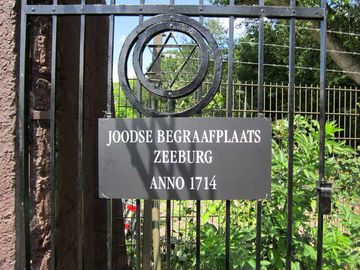

A few gravestones is all that remains of some 200,000 that had once stood here. In 1714, after a large plot of land was drained, the Jewish cemetery was established here by the Ashkenazi community whose coat of arms decorates the gate. Thanks to immigrants from Eastern Europe, the Ashkenazi community grew rapidly around the turn of the 18th century, thus rendering the Jewish cemetery in Muiderberg, in use since 1642, too small. This cemetery was intended for the poor who could not pay for their own grave and were, thus, buried in public graves without leaving so much as a name. Zeeburg was also the burial site for those who died on Friday, a public holiday. There are a few tombstones dating back to the first one hundred and fifty years. In the early twentieth century the cemetery was full and in Diemen a new cemetery was opened in 1914. Until 1942 regular burials took place, until the deportation of the Jewish community started during the Second World War. After the war, the cemetery fell into disrepair; the tombstones were grown over with weeds and sank into the marshy soil. The Jodenmanussie, once the largest Jewish cemetery in Western Europe, became unkempt and fell into oblivion. Residents of the Indischebuurt used it as a playground and for walking their dogs. After an article was published by a famous Dutch journalist, the entrance was cemented.
Rehabilitation of the Jodenmanussie started in 2006 with renovating the premises. A new entry gate was installed, a part of the cemetery was mowed to make the stones visible again, and the first rows of the stones were restored. In addition, there are plans to restore the cemetery so that funerals could be performed again, albeit on a modest scale. In fact, this has been already happening, as can be observed the new row of tombstones. At least once every ten years someone must be buried in Zeeburg in order for the Jewish community to keep the right to the grounds. Between April and October, the cemetery is open to the public every first Sunday of the month.